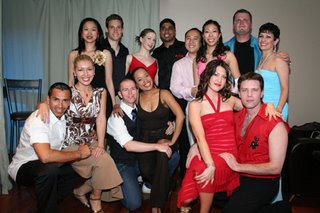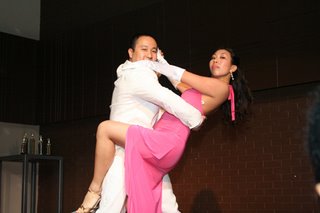 The temperatures were rising in the month of May in Toronto, and on Friday May 25 temperatures soared inside Six Degrees nightclub on Yonge and Eglington. Things were fever pitch as competitors salsa danced, spun, styled, shined, dropped and lifted themselves towards winning the first (hopefully annual) Toronto Dance Salsa amateur competition. You may have been there or have already read on the internet that Nina and Alfred were the winners of the competition. We can only say that we were excited going into the competition, and was amazed at all the support and encouraging words we received from everyone. So to all of those who encouraged us and gave us support, a great big thanks! The desire to put on a good show and not let anyone down with their expectations really kept us going. We’re certainly happy we did not disappoint.
The temperatures were rising in the month of May in Toronto, and on Friday May 25 temperatures soared inside Six Degrees nightclub on Yonge and Eglington. Things were fever pitch as competitors salsa danced, spun, styled, shined, dropped and lifted themselves towards winning the first (hopefully annual) Toronto Dance Salsa amateur competition. You may have been there or have already read on the internet that Nina and Alfred were the winners of the competition. We can only say that we were excited going into the competition, and was amazed at all the support and encouraging words we received from everyone. So to all of those who encouraged us and gave us support, a great big thanks! The desire to put on a good show and not let anyone down with their expectations really kept us going. We’re certainly happy we did not disappoint.
Some may wonder: what got us to participate, how we prepared, how much time we spent, how we put together the choreography and what were our feelings before, during, and after the final competition. So let’s start at the beginning, how did we become contestants? When we first heard about the competition from Sharon, we were a bit shy to the concept. Nina was definitely not completely keen on the idea. The obvious initial questions were: “Are we good enough? Do we have time to do this? How does one choreograph such a thing?” One thing was for certain – both of us are always keen on looking for ways to improve our dancing. Alfred was certain that this would be a good route to dedicate time and effort with a defined end goal that would lead to improvements in the long run. So in the end, Alfred had convinced Nina that entering the competition would be a great idea, and Nina’s only caveat was that there was a commitment to properly set aside time. Alfred’s work commitments often get in the way of salsa, and that became the main concern. With Alfred’s promise to set aside the required time to put together the choreography and practice, they were set.
As soon as they confirmed their entry into the competition, we went straight to work. First off was picking a song. This was more difficult than what was imagined. There were so many things we considered: tempo (fast enough to be interesting, but not so fast that execution of difficult moves would be impossible,) style (Cuban, romantica, hiphop infused mashup, jazz or blues infused,) is it a song we could imagine listening to over and over again for two months without getting sick of it? From our library of salsa music, we narrowed it down to about a dozen songs that we would want to perform with, and then came a week of listening to them over and over again, trying to see if there was the right amount of breaks and accents to incorporate moves into, enough variety in the melody for patterns and shines, and finally was there enough “salsa feel” to the song. In the end, our pick was Arrepentidos Pecadores by Willie Rosario. The song hadn’t been overdone by existing performers, had a good tempo, good variety and didn’t seem we would be annoyed with the song after a couple months of constant play.
With a song picked out, the next challenge we came up to was, what would we wear and how to put together the choreography? Neither of us had choreographed a salsa routine before, but for anyone thinking of performing next year or in the future, do not overlook the amount of time to be invested in this area. Things that we kept as priorities included: focus on good salsa technique, variety in movement and patterns, tight shines that are challenging but look effortless, musicality and ensuring patterns and styling fit in with the music, and how to get enough wow factor that the judges and audience will take notice. All that in two months? Alfred began to worry about the daunting task at hand, but applying his project management skill broke things down into pieces with milestone dates. First was a time consuming research phase. We watched video upon video of salsa performances to learn some key fundamentals about what we liked and disliked from professional dancers. We watched recordings of So You Think You Can Dance, performances from our favorites such as: Alex de Silva, Al “Liquidsilver Espinoza,” Frankie Martinez, and Tropical Gem, we watched winning performances from the Mayan Competitions, the World Salsa Championships (http://www.worldsalsachampionships.com), and any instructional video we could get our hands onto.
 All the while we were researching the choreography; Alfred listened to the song every day – a zillion times a day. This really makes one thankful for not choosing a song that one tires of easily. The song was broken down into sections according to it’s musicality: accents, breaks, places for shines, places for multiple spins. With a good understanding of the music it came time to putting together moves to more workable segments of music. Of the two and a half minute song, we basically went in 30-40 second pieces, where either turn patterns or shines were evaluated over and over again. When it all seemed to fit, the next section was choreographed and then a transition between the two would be put together. I can’t say enough how important access to mirrors and some sort of video recording device is to doing this sort of thing. It is one thing to imagine how you look, or how coordinated your moves are. The truth is in the pudding of watching yourself on camera, or synchronizing your shines and steps in the mirror. On camera it is of course sometimes painful to watch, but better in rehearsals and choreography than on stage for the world to see.
All the while we were researching the choreography; Alfred listened to the song every day – a zillion times a day. This really makes one thankful for not choosing a song that one tires of easily. The song was broken down into sections according to it’s musicality: accents, breaks, places for shines, places for multiple spins. With a good understanding of the music it came time to putting together moves to more workable segments of music. Of the two and a half minute song, we basically went in 30-40 second pieces, where either turn patterns or shines were evaluated over and over again. When it all seemed to fit, the next section was choreographed and then a transition between the two would be put together. I can’t say enough how important access to mirrors and some sort of video recording device is to doing this sort of thing. It is one thing to imagine how you look, or how coordinated your moves are. The truth is in the pudding of watching yourself on camera, or synchronizing your shines and steps in the mirror. On camera it is of course sometimes painful to watch, but better in rehearsals and choreography than on stage for the world to see.
As time came closer to the preliminary competition, we had choreographed an entire forty seconds for two and a half minutes. Things were slower than we had hoped, but then we realized, we should practice for the preliminaries. So we went out to Babaluu’s as much we could to practice our social dancing, and luckily we made it through the preliminary round.
No time for rest though, as soon as the preliminaries were over, it was time to get back to the choreography. Week by week, we were practicing our routine almost every day. It was quite a commitment to come home after a long day at the office, or to spend a Saturday after a long week adding more to the choreography and practicing. But in the end it was worth it. As some have guessed, we brought in some assistance as well by hiring Caryl to assist with cleaning up the transitions and adding much needed pointers on styling and improving our dancing. Our focus of the competition throughout was in the interest in improving our salsa, so it only made sense to ensure we weren’t developing or reinforcing bad habits by the many hours we were devoting to practice. With help many long hours of practice and Caryl’s assistance, we finally completed the choreography just a week before the competition date. We practiced the routine over and over again, piece by piece, from the front, from the middle, without music, with music, with the lights low, with the lights on, with background noise, almost any crazy way Alfred could imagine may prepare us for any scenario that would occur. Finally before we knew it, it was the night before.


